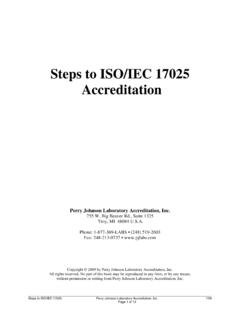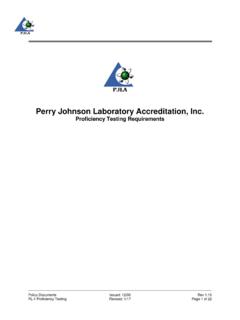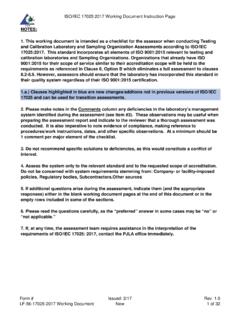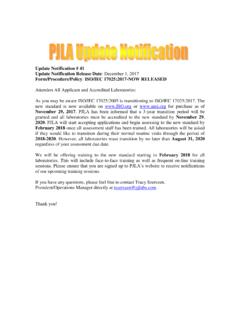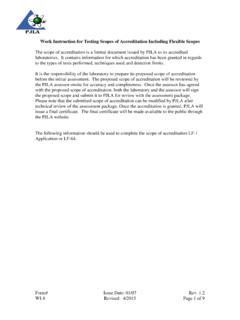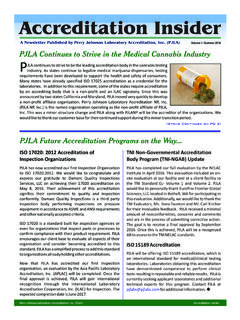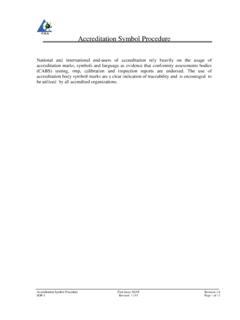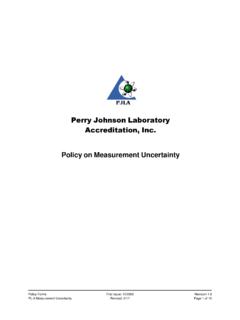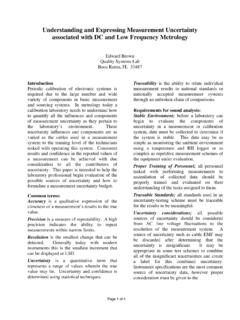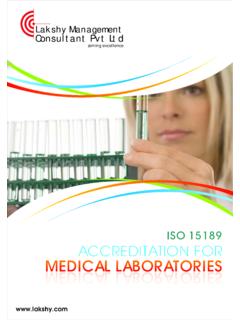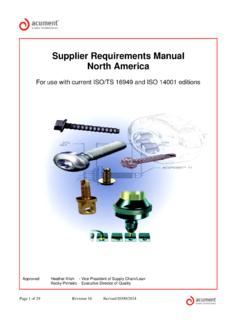Transcription of Perry Johnson Laboratory Accreditation, Inc.
1 Policy Forms Issued 12/00 Rev PL-2 Measurement Traceability Revised: 1/17 Page 1 of 9 Perry Johnson Laboratory accreditation , Inc. Measurement Traceability Policy Measurement Traceability Policy Policy Forms Issued 12/00 Rev PL-2 Measurement Traceability Revised: 1/17 Page 2 of 9 INTRODUCTION The following pages describe the responsibilities of organizations seeking accreditation by PJLA in reference to measurement traceability. The policy detailed within this document applies only to calibrations or tests for which an accredited result is to be reported. For the purpose of this procedure, the term traceability is defined as the process by which the result of a measurement is compared to an international or national standard. Traceability is characterized by a number of essential elements1: an unbroken chain of comparisons, going back to a standard acceptable to the parties; usually a national or international standard; measurement uncertainty, the measurement uncertainty for each step in the traceability chain must be calculated according to defined methods and must be stated so that overall uncertainty for the whole chain may be calculated or estimated; documentation, each step in the chain must be performed according to documented and generally acknowledged procedures; the results must be equally documented; competence, the organizations or bodies performing one or more steps in the chain must supply evidence for their technical competence.
2 , by demonstrating that they are accredited reference to the SI units, the chain of comparisons must, where possible, end at primary standards for the realization of the SI units, and; calibration intervals, calibrations must be repeated at appropriate intervals; the length of these intervals depends on a number of variables. , uncertainty required, frequency of use, manner of use, stability of equipment DEFINITIONS Metrological Traceability (VIM clause ): Property of a measurement result whereby the result can be related to a reference through a documented unbroken chain of calibrations, each contributing to the measurement uncertainty. Note 1, clause states that a reference can be a definition of a measurement unit through its practical realization, or a measurement procedure including the measurement unit for a non-ordinal quantity, or a measurement standard Metrological Traceability Chain (VIM clause ): Metrological traceability where the reference is the definition of a measurement unit through its practical realization.
3 Note 1-The expression traceability to the SI means metrological traceability to a measurement unit of the International System of Units. National Metrology Institutes (NMI) and Designated Institutes (DI): Organizations that maintain standards in countries (regions), all over the world. Throughout this document the term NMI is used to cover both National Metrology Institutes as well as Designated Institutes. Measurement Traceability Policy Policy Forms Issued 12/00 Rev PL-2 Measurement Traceability Revised: 1/17 Page 3 of 9 Joint Committee for Traceability in Laboratory Medicine (JCTLM): The CIPM, IFCC and the ILAC platform to promote and give guidance on internationally recognized and accepted equivalence of measurements in Laboratory Medicine and traceability to appropriate measurement standards.
4 Bureau International des Poids & Measures (BIPM): Ensures world-wide uniformity of measurements and their traceability to the International System of Units (SI). It does this with the authority of the Convention of the Metre, a diplomatic treaty between fifty-five nations, and it operates through a series of Consultative Committees, whose members are the national metrology laboratories of the signatory States, and through its own Laboratory work. The BIPM carries out measurement-related research. It takes part in, and organizes, international comparisons of national measurement standards, and it carries out calibrations for Member States. Key Comparison Database (KCDB): A public website containing all information relating to the CIPM MRA, an arrangement establishing the equivalence of measurements made by, and certificates issued by, all the participating institutes signatory to the National Metrology Institutes and other designated institutes.
5 In-house Calibration: A calibration performed by an organization of its own equipment for use in its accredited calibration or testing activities. By definition an in-house calibration is a calibration the organization is not accredited to perform. An organization must establish traceability for the results of in-house calibrations with the same degree of rigor required of accredited calibrations. The following requirements must be meet for all in-house calibrations: a clearly defined quantity that has been measured; , the actual size represented by a micrometer when indicating inches a complete description of the measurement system or working standard used to perform the measurement; , a grade 00 ceramic gage block with a stated size of in and an uncertainty of +/- 2 in a stated measurement result or value, with a documented uncertainty; , in with an uncertainty of +/- 57 in a complete specification of the stated reference at the time the measurement system or working standard was compared to it.
6 , Mitutoyo 102-717 0-1 in micrometer with in resolution S/N 017189 an "internal measurement assurance" program for establishing the status of the measurement system or working standard at all times pertinent to the claim of traceability, and; , control chart based on the last 11 years of calibration results for the 00 gage block set with defined limits of variation and specified actions to be taken should these limits be exceeded Measurement Traceability Policy Policy Forms Issued 12/00 Rev PL-2 Measurement Traceability Revised: 1/17 Page 4 of 9 an "internal measurement assurance" program for establishing the status of the stated reference at the time that the measurement system or working standard was compared to it. , a system of intermediate checks performed per a documented procedure and schedule TRACEABILITY REQUIREMENTS: CALIBRATION &TESTING ORGANIZATIONS INCLUDING CLINICAL TESTING LABORATORIES (ISO 15189) In order to achieve accreditation , the applicant organization must have documented policies and procedures for the calibration of all equipment having a significant effect on the accuracy or validity of results (ISO/IEC 17025:2005, Section and ISO 15189:2012 Section ).
7 Knowledge of the organizations in-house calibrations should be utilized by PJLA in scheduling assessments and determining assessor assignments. In addition, knowledge of in-house calibrations shall be utilized by the assessor in preparing the assessment plan. Assessors are required to obtain evidence that the results of in-house calibrations are traceable to the SI where such traceability is possible and appropriate. Such evidence of traceability is to be included in the assessment package submitted. This significance shall be determined using the method specified in the Estimation of Measurement Uncertainty procedure of the applicant organization. The process defined in the aforementioned procedure shall ensure that the results of calibrations and measurements made by the organization are traceable to the International System of Units (SI) through an unbroken chain of comparisons (ISO/IEC 17025:2005 Section , ISO 15189:2012 Section ) Calibration certificates issued by the accredited organization for calibrations performed must provide evidence that measurement results are traceable when this is necessary for the interpretation of results ISO/IEC 17025:2005 Section 5.
8 If the organization chooses to reference this traceability on calibration certificates, it must reference traceability to the SI when possible and if not possible the appropriate measurement standards as listed (ISO/IEC 17025:2005 Section ) must be identified. This can be accomplished through inclusion of a statement similar to the following on the certificate or report. The calibration results published in this certificate were obtained using equipment capable of producing results that are traceable through NIST to the International System of Units (SI) This statement is intended only as an example and other statements which express the same intent would be acceptable. Measurement Traceability Policy Policy Forms Issued 12/00 Rev PL-2 Measurement Traceability Revised: 1/17 Page 5 of 9 A simple example for an unbroken chain of comparisons is as follows: SI National Metrology Institute (NMI) Higher level calibration organization Applicant calibration or test organization Note: Estimations of measurement uncertainty must be calculated, or provided, for each part of the chain so that the overall uncertainty of measurement can be calculated.
9 For testing organizations, a rigorous, mathematically, and statistically valid estimate of the measurement uncertainty may not be possible, so the requirements (in ISO/IEC 17025:2005 , ISO 15189:2012 Section ) would apply. In such cases the organization must identify all the components of uncertainty and make a reasonable estimation . The reasonable estimation is to be based on knowledge of the performance of the method and on the measurement scope. It also shall make use of previous experience and validation data. It can also be based on consensus standards such as ASTM E2554-13, where a well-recognized test method specifies limits to the values of the major sources of uncertainty of measurement and specifies the form of presentation of calculated results. In these cases the Laboratory is considered to have satisfied this clause by following the test method and reporting instructions (ISO/IEC 17025:2005 incl.)
10 Note 2.) The relationship between the measurement result and the SI can also be demonstrated by reference to (listed in order of precedence): primary standards2: measurement standard established using a primary reference measurement procedure, or created as an artifact, chosen by convention; secondary standards2: measurement standard established through calibration with respect to a primary measurement standard for a quantity of the same kind, and; intrinsic measurement standard2: measurement standard based on an inherent and reproducible property of a phenomenon or substance. There are some calibrations and tests for which a direct link to the SI is not possible. If traceability to the SI cannot be realized, the applicant organization shall establish traceability to appropriate measurement standards such as: (listed in order of precedence): the use of certified reference materials provided by a competent supplier to give a reliable physical or chemical characterization of a material or condition; Measurement Traceability Policy Policy Forms Issued 12/00 Rev PL-2 Measurement Traceability Revised: 1/17 Page 6 of 9 the use of specified methods and/or consensus standards that are clearly described and agreed upon by all parties concerned (ISO/IEC 17025:2005 and ISO 15189:2012); values associated with reference materials (RMs) may not be traceable.
